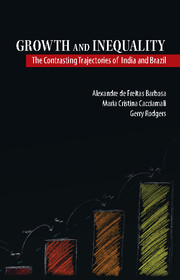Book contents
- Frontmatter
- Contents
- List of Tables
- List of Graphs and Maps
- Preface and Acknowledgements
- List of Abbreviations
- 1 Brazil and India: A Mirror Image of Each Other?
- 2 Approach and Method
- 3 Brazil and India in the Decades before 1980
- 4 India and Brazil from 1980 until 2014
- 5 Key Divides and Cleavages: Ruptures, Continuities, or Adaptation?
- 6 Inequality in Social and Economic Context
- 7 Post-Script
- Bibliography
- Index
3 - Brazil and India in the Decades before 1980
Published online by Cambridge University Press: 02 August 2019
- Frontmatter
- Contents
- List of Tables
- List of Graphs and Maps
- Preface and Acknowledgements
- List of Abbreviations
- 1 Brazil and India: A Mirror Image of Each Other?
- 2 Approach and Method
- 3 Brazil and India in the Decades before 1980
- 4 India and Brazil from 1980 until 2014
- 5 Key Divides and Cleavages: Ruptures, Continuities, or Adaptation?
- 6 Inequality in Social and Economic Context
- 7 Post-Script
- Bibliography
- Index
Summary
Chapters 3 and 4 review the patterns and trends of economic and social inequality in Brazil and India since the middle of the twentieth century. As noted above, 1980, or the early 1980s, is an important dividing line in both countries (as it was in much of the world), albeit for different reasons, and we therefore separate the discussion into two parts, treating the period up to 1980 in Chapter 3 and the period after 1980 in Chapter 4.
In both chapters, the first section presents the broad picture – the political and social environment, the nature of growth and capital accumulation, the underlying social and economic institutions, and how these different elements of the growth regime emerged, changed and underpinned a historically specific pattern of inequality. The following three sections in each chapter examine particular dimensions of the growth regime. We first discuss the macroeconomics of the growth regime, in terms of the pace of growth and of capital accumulation, sectoral patterns of final demand, output and employment, and the resulting level of inequality and poverty in the economy as a whole. The next section examines labour institutions and labour markets. A central focus of this study is the nature and extent of labour market inequality, and how it relates to broader aspects of distribution. Key factors include the type of labour market segmentation and its relationship with heterogeneity in the production system, wage differentiation and wage shares, the regulatory framework and other labour market interventions such as the minimum wage, and the organization of labour. The final section considers more specifically the role of the state, and how state policy has impacted on inequality, through the pattern of government expenditure, through direct redistribution and through social policies. In many of these areas, more can be said for the period after 1980, when data sources are usually more extensive.
With such a broad compass it is not possible to examine all of these issues in depth – the aim has been to present the overall picture, sometimes at the cost of loss of detail. But in Chapter 5 we complement the systemic approach of Chapters 3 and 4 with a more detailed discussion of some pervasive dimensions of inequality – gender, region, caste, race and education – using analytical categories and measures that can be compared between the two countries.
- Type
- Chapter
- Information
- Growth and InequalityThe Contrasting Trajectories of India and Brazil, pp. 19 - 84Publisher: Cambridge University PressPrint publication year: 2017



